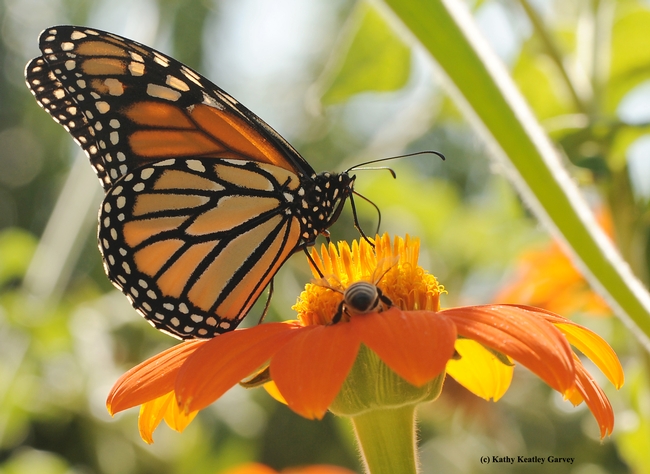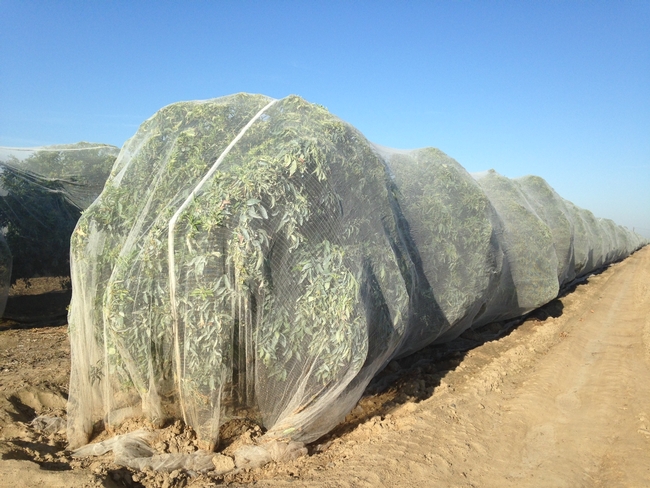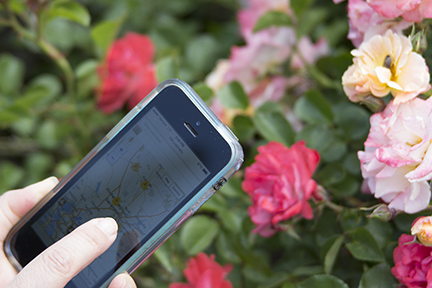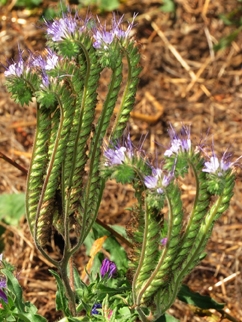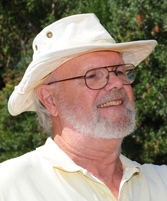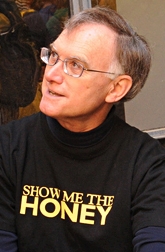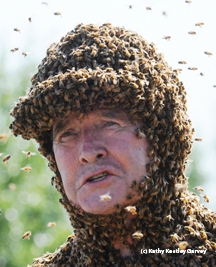Posts Tagged: Eric Mussen
To bee or not to bee depends on the crop
Bees do it. Birds do it. Even bats do it. They all help plants reproduce by carrying pollen from one flower to another. Beetles, butterflies, wasps, flies and moths are also pollinators.
About 35 percent of the food we eat depends on the assistance of bees to pollinate plants and trees so they will produce fruit, nuts or vegetables. It takes 1.6 million colonies of honey bees to pollinate California's 800,000 acres of almond trees.
Our food choices would be dramatically reduced if bees weren't around to pollinate. To illustrate what the produce section of a grocery store would look like in a world without bees, Whole Foods Market removed the products that depend on pollination from one of its stores and took a photo. See the difference: http://ucanr.tumblr.com/post/84164840510/kqedscience-whole-foods-shows-customers-the. Without bees, more than half the fruits and vegetables were eliminated.
Honey bees and other pollinators are being threatened by the drought, disease, mites, loss of habitat and food sources, according to Eric Mussen, UC Cooperative Extension specialist in the Department of Entomology at UC Davis and bee expert.
But not everyone wants help from pollinators. To produce seedless fruit, some citrus growers cover their mandarin trees to keep out bees because the mandarins, or tangerines, produce seeds if the tree is pollinated. Most consumers prefer their mandarins to be seedless.
Beth Grafton-Cardwell, UC Cooperative Extension specialist in the Department of Entomology at UC Riverside and director of Lindcove Research and Extension Center, talks about the role of pollinators in California agriculture in this video: http://www.youtube.com/watch?v=8suOt5PnzWc&feature=youtu.be.
To see photos of different kinds of pollinators and to learn more about how to help them thrive, visit our pollinator page. On May 8, help count the pollinators in your community and add them to the map at http://beascientist.ucanr.edu.
Honey bees: Should they be banned from native plant restoration areas?
What’s a honey bee to do?
The dwindling resources of pollen and nectar-producing plants in California greatly concern bee scientists and beekeepers, and rightfully so.
But the dwindling resources also greatly concern native pollinator specialists and native plant enthusiasts. Some worry that honey bees, which are non-natives, may be "reducing" or "eliminating" native pollinators through competition for food.
Are they?
Extension apiculturist Eric Mussen of the UC Davis Department of Entomology and Nematology explains that a number of agencies and organizations are cooperating in an effort to "restore" regions of the California Central Valley to their "original state."
“The major emphases are (1) replacing non-native vegetation with native plants and (2) encouraging native animals to return to their former ranges,” Mussen says. "The result has been eviction of beekeepers from apiary locations that have been used for decades as seasonal spots for rebuilding populations following the stresses of commercial pollination or for producing honey."
“While removing this non-native pollinator from an environment may sound rational at first, it may not be the best idea,” Mussen points out. “In most cases, it is not the presence of honey bees that has depressed or eliminated the populations of native pollinators. In fact, no studies have shown that honey bees eliminate native pollinators. In some cases, the populations of native pollinators have been reduced by honey bee competition, but following removal of honey bees the native bees built back to usual levels in a couple years.”
Indeed, in some situations, honey bees can survive, and native pollinators can’t.
“With honey bees, if we provide them with an adequate hive and food sources, they are likely to survive,” Mussen says. “However, native pollinators can be very particular about the environment in which they can exist. If their nesting habitat is disturbed, modified or destroyed, they cannot live in the area, despite an abundance of food plants. In many California locations, it is habitat alteration or destruction, not lack of food, which eliminated the native pollinators.”
When native habitats are compromised, “honey bees may be essential to foster initial re-establishment of native plant populations,” Mussen relates. “Those plants provide food and shelter for wildlife and assist significantly in erosion control. Until the habitat is restored adequately to meet the requirements of native pollinators, it is likely that the presence of honey bees will be much more beneficial than detrimental in keeping the California native plants pollinated and reproducing.”
So, should honey bees be banned from restoration areas?
"No," Mussen says. "Honey bees should be solicited for restoration areas, not banned."
Mussen shares a list of 130 native California plants that are likely to be visited - "and probably pollinated" - by honey bees. They include button bush or button willow, fiddleneck, and California golden poppy. The list is excerpted from Nectar and Pollen Plants of California by G. H. Vansell UC Berkeley, plus personal observations by native pollinator specialist Robbin Thorp, UC Davis emeritus professor of entomology. The list is updated, reflecting information on the CalFlora website and the Jepson Manual of Higher Plants of California.
Thorp, who monitors the Häagen-Dazs Honey Bee Haven, planted in the fall of 2009 on Bee Biology Road, UC Davis, has found more than 80 different species of bees - and counting - in the half-acre bee garden. It's located next to the apiary at the Harry H. Laidlaw Jr. Honey Bee Research Facility.
So honey bees and native bees share the resources.
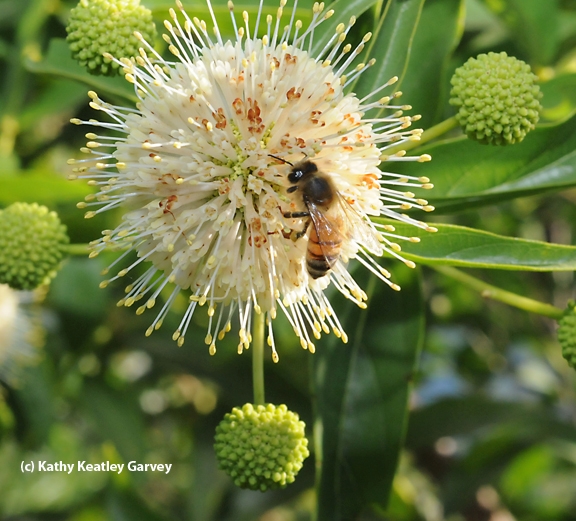
A honey bee foraging on button willow, also known as button bush, Cephalanthus occidentalis. Honey bees on non-natives, and the button bush is a native California plant. (Photo by Kathy Keatley Garvey)
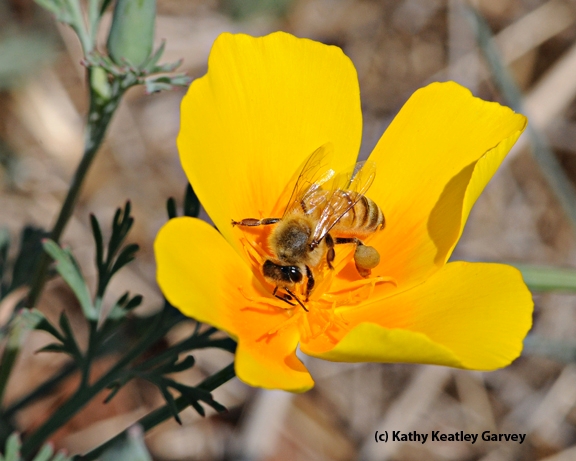
Honey bee visiting California golden poppy, Eschscholzia spp. (Photo by Kathy Keatley Garvey)
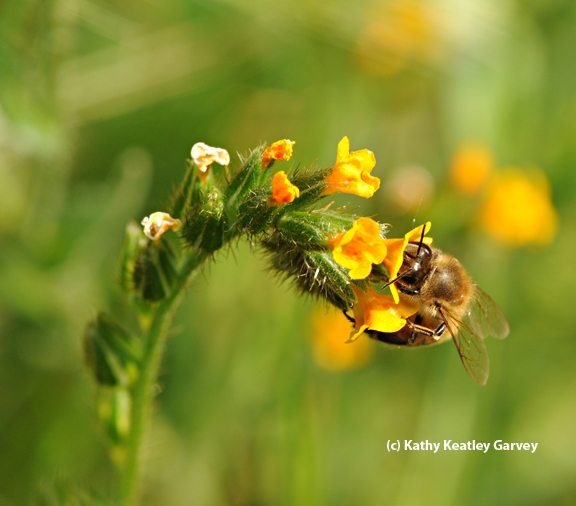
Honey bee foraging on fiddleneck, Amsinckia spp. (Photo by Kathy Keatley Garvey)
The fruits of their labors
Summer time...and the livin' is easy.
But not for the bees. Worker bees, which live about four to six weeks, literally work themselves to death gathering nectar, pollen, propolis (plant resin) and water to bring back to their colony.
So, when you sit down to summer meals, you can thank a bee.
Extension apiculturist Eric Mussen of the UC Davis Department of Entomology and Nematology, says one-third of the American diet is pollinated by bees. Without bees, we'd be eating such wind-pollinated grains as wheat and rice.
Our gardens and orchards yield such favorites as carrots, cucumbers, onions, apples, grapefruit, oranges, pears, cherries, raspberries, strawberries, blueberries, lima beans, sunflowers and almonds.
All pollinated by honey bees.
Cole crops, such as cabbage, Brussel sprouts, collards, kale, kohlrabi, spinach, chard and broccoli?
All pollinated by honey bees.
Even milk and ice cream are linked closely to the honey bee. Cows feed on alfalfa, which is pollinated by honey bees (along with other bees). Ice cream ingredients usually include fruits and nuts, other bee favorites.
The ever-popular fruit salad features blueberries, apples, oranges and pomegranates.
All pollinated by honey bees.
An apple a day may keep the doctor away, but without the bees, we'd have no apples.
Love apples and honey? Here are two recipes from the National Honey Board celebrating both honey and apples.
Apple honey crisp
2 lbs. apples, quartered and sliced (1-1/2 quarts)
1/2 cup plus 1/4 cup honey, (separated)
1 teaspoon cinnamon
1/2 teaspoon nutmeg
1 cup flour
1/4 cup butter, softened
Warm Nutmeg Cream, (recipe follows) or ice cream
Toss apples with 1/2 cup honey, cinnamon and nutmeg in bowl. Turn into 2-quart baking dish. For topping, beat flour with butter and 1/4 cup honey until crumbly; sprinkle over apples. Bake at 350 degrees for 40 to 45 minutes or until apples are tender and topping is golden. Serve with warm nutmeg cream or ice cream.
Warm nutmeg cream
1/2 cup whipping cream
2 tablespoons honey
2 tablespoons butter
1/4 teaspoon nutmeg
Combine all ingredients in saucepan and bring to boil. Simmer, stirring often, for 5 minutes or until mixture thickens slightly.
Honey apple cake
1/3 cup butter or margarine
1/3 cup packed brown sugar
2 eggs
1/3 cup honey
1 teaspoon grated lemon peel
1-1/2 cups flour
1 teaspoon baking powder
1/2 teaspoon baking soda
1/2 teaspoon ground cinnamon
1/4 teaspoon salt
1/4 teaspoon ground nutmeg
1/8 teaspoon ground allspice
1/4 cup water
1 cup (1 medium) pared, cored, & chopped apple
1/4 cup chopped walnuts
Honey Apple Topping
Cream butter and sugar until light and fluffy. Add eggs, one at a time; beat after each addition. Beat in honey and lemon peel. Combine flour, baking powder, soda, spices and salt; mix well. Add to creamed mixture alternately with water; begin and end with dry ingredients. Stir in apples and nuts. Turn into greased and floured 9-inch heart-shaped or round cake pan. Bake at 325 degrees F. for 45 to 55 minutes or until wooden toothpick inserted near center comes out clean. Cool 10 minutes and remove from pan. Cool completely. Brush top of cake with sauce from honey apple topping; arrange topping on cake.
Honey apple topping
1/3 cup honey
2 tablespoons rosé wine
2 tablespoons lemon juice
2 medium apples
Heat honey, rosé wine and lemon juice. Core and slice 2 medium apples; add to honey. Cook until tender and glazed; turn slices halfway through cooking. Makes topping for one 9-inch cake.
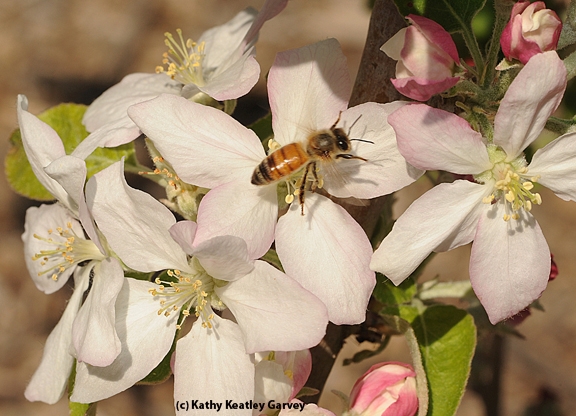
Honey bee pollinating apple blossom. (Photo by Kathy Keatley Garvey)
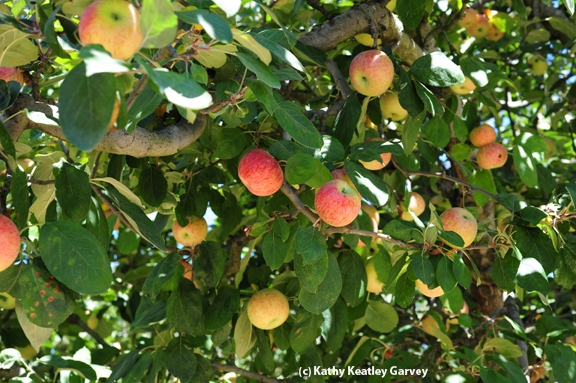
Gravenstein apples ready to be picked. (Photo by Kathy Keatley Garvey)
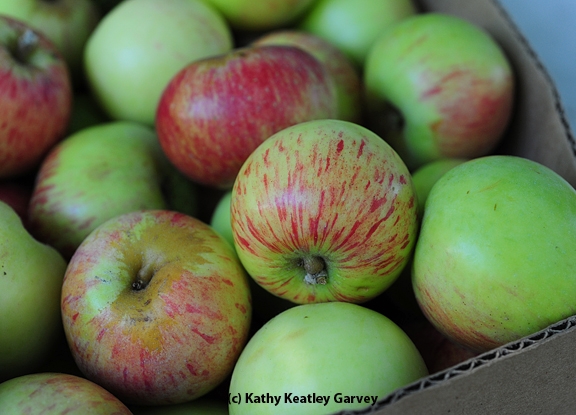
Gravenstein apples ready to eat. (Photo by Kathy Keatley Garvey)
Honey, I hardly know you!
“My jar of honey went bad so I threw it away.”
How many times have you heard that?
It did not go “bad” but it did granulate, as honeys do. Granulation is the formation of sugar (glucose) crystals. Reheat the honey and it’s good to go — and eat.
“Most honeys granulate during storage after extended periods of time in containers,” says honey bee specialist/bee wrangler/six-decade beekeeper Norman Gary, emeritus professor in the Department of Entomology at UC Davis and author of the best-selling beginning beekeeping book, Honey Bee Hobbyist: The Care and Keeping of Bees.
“Sometimes honey granulates while still sealed in the comb,” Gary says. ”The basic reason honey granulates is that the bees have dissolved more sugar in the solution — a process called super saturation — than it can hold during storage. The tendency to granulate is determined primarily by the concentration of glucose. Excess glucose forms crystals of glucose hydrate that aggregate in a lattice in the honey."
Eric Mussen, UC Cooperative Extension specialist in Department of Entomology at UC Davis, says that nearly every variety of honey granulates over time, “since it is a supersaturated sugar solution. Hazy, crystallized, or solidified honey is not spoiled. Loosen the cap and place the container in hot water – the honey will return to its liquid state with stirring. When the sugar crystals release free water in honey, it can ferment. At that point it cannot be salvaged.”
Short-bursts in the microwave are also a good way to liquefy honey, Gary says. He advocates heating the glass jars in 30-second intervals, stopping and stirring.
“Monitor the temperature so you don’t have to heat more than necessary to achieve liquefaction.” High temperatures can "cause chemical changes that some purists consider to be heat damage.” It can also change the delicate flavors and darken the honey.
Some honeys do not crystallize or crystallize so readily. Tupelo honey, produced from the nectar of tupelo trees, does not granulate, Gary says.
As for the taste of honey, Mussen points out that honey tastes sweeter than sucrose “since it contains free fructose, which tastes sweeter to us than does sucrose. There also is free glucose in honey, but that does not taste exceptionally sweet to us.”
Meanwhile, misconceptions about honey continue to persist. Bees make honey from nectar secreted from flowers. Uninformed children may think brown cows give chocolate milk and that different colors of bees account for the different colors of honey. (Even a business professional told me last week that she thought that a specific honey bee makes orange blossom honey, and another bee makes clover honey.)
“The colors and flavors of honey are properties of the nectar collected by the bees, not of the bees producing the honey,” Mussen says. “Climate impacts the nectar. Honey produced from alfalfa bloom can be transparent or 'water white;' golden, as in 'clover' honey, or significantly darker, approaching amber, when it is produced in northern Canada, mid-western U.S., or southern U.S., respectively. If you wish to find specific varieties of honey to compare, many varieties and sources can be found at http://www.honeylocator.com/, overseen by the National Honey Board.”
Mead is another term that puzzles folks. It's an alcoholic beverage made with honey.
“Honey is the basic source of sugar for the fermentation of mead," Mussen explains. "Meads can be dry or sweet, depending upon the desire of the mead maker. With the addition of spices or fruit juices, meads are called various names: metheglin, hippocras, cyser or pymet.”
And, if you cook with honey, be aware of the properties.
“In baking and beverages honey often can be substituted directly for sugar,” Mussen says. “Lighter colored honeys usually are milder tasting, while the darker honeys are more robust. That is not always the case. Honey has around 17 percent water content, so for baking, it sometimes is good to reduce the volume of other liquids in the recipe. Also, honey tends to turn brown when baking, so reduce the heat by 25 degrees or so if less browning is desired. The finished baked product is apt to remain 'fresh' (moist) longer than sugar-based recipes, due to the presence of free fructose that attracts water moisture. Lining the measuring cup with a very thin film of cooking oil will let the honey slip right out, instead of sticking in the cup."
If you’re anxious to sample different honey varietals, head over Briggs Hall during UC Davis Picnic Day on April 20. Mussen will be offering his traditional free honey tasting. Last year he provided six kinds of honey: California buckwheat, avocado, eucalyptus, sage, orange, and cactus. In the past, visitors also tasted cotton honey, blackberry honey and starthistle honey and others.
Starthistle (Centaurea solstitialis), native to Eurasia is an exotic invasive weed hated by just about everybody but the beekeepers and the lovers of starthistle honey.
“Starthistle honey is the champagne of honey,” said Yolo County beekeeper Dennis Price of Good Bee Apiary. “It’s the best there is. However, this year’s starthistle may not be so good due to the lack of rain."
Like to cook with honey? Try the time-tested recipes on the National Honey Board website.
Beekeeper Kim Flottum, editor of Bee Culture magazine and author of the book, The Backyard Beekeeper, offers a number of recipes in his book, including these two toppings--just in time for spring!
Orange honey butter for cornbread
1/2 cup unsalted butter, at room temperate
1/8 teaspoon salt, or to taste
1 tablespoon orange zest, finely grated (1 medium to large orange)
1 tablespoon honey
Prepared corn bread
Put the softened butter into a bowl with the salt and whisk until creamy. Whisk in the orange zest and then the honey. Whisk until smooth. Warm cornbread at 250 degrees for 5 to 10 minutes. Remove from the oven and brush with a little orange honey butter. Col about 15 minutes before cutting into wedges. Serve with the remaining butter.
Orange cream spread
1 package (8-ounce) cream cheese
1/4 cup honey, mild
2 tablespoons orange juice
1/2 teaspoon orange peel or zest
Combine softened cream cheese, honey, orange juice, and orange peel. Blend well. Refrigerate at least one hour—overnight is better. Spread on rolls, muffins or croissants.
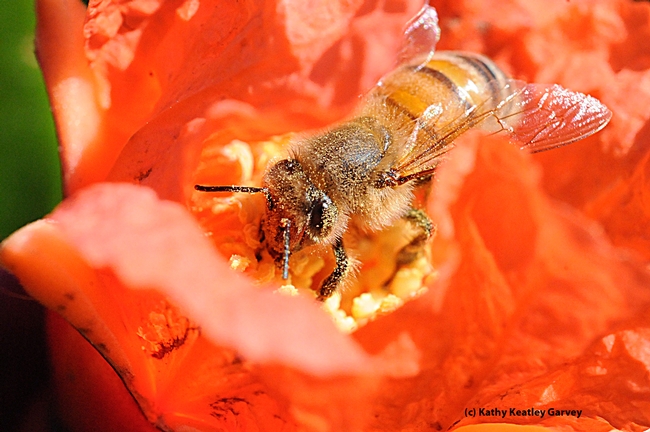
Honey bee foraging on pomegranate blossom. Pomegranate honey is the result.(Photos by Kathy Keatley Garvey)
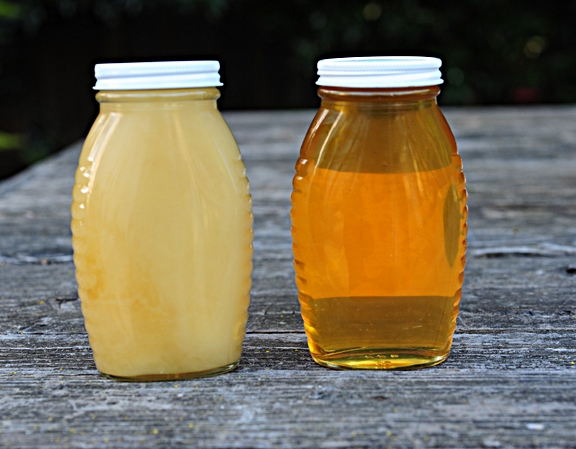
Starthistle honey: granulated or crystalized on the left; liquid honey on the right.
California weather has been perfect for almond set
The warm, dry late winter weather in California has been good news for almond farmers who were concerned about a bee shortage during bloom, reported Capital Press.
"It looks good right now," said Rich Buchner, UC Cooperative Extension advisor in Tehama County. "The bees are out working like crazy. It's going to be warm and dry over the next 10 days, so it should be about perfect for almond set."
Almond growers are enjoying a vibrant blossom season even though California only had about 500,000 bee colonies available as of mid-February to pollinate this year's crop of 800,000 acres, according to Eric Mussen, UCCE specialist in the Department of Entomology at UC Davis. Typically, as many as 1.6 million are needed to provide two colonies per acre.
The favorable weather for bee activity comes with a catch, however. Precipitation totals are behind seasonal averages.
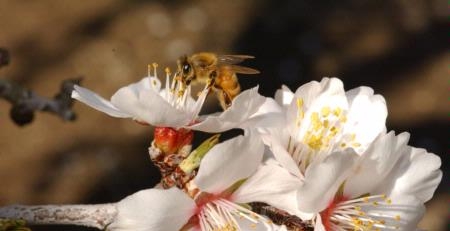
A honey bee on an almond blossom. (Photo: Kathy Keatley Garvey)

